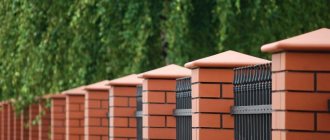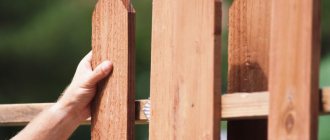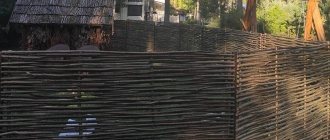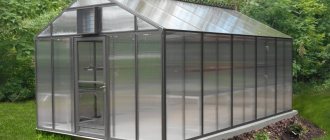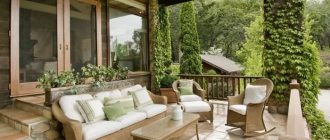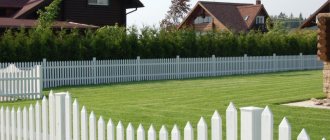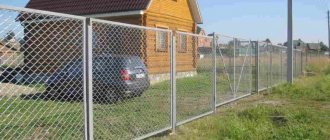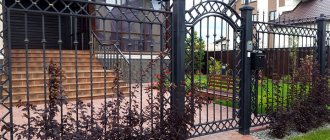The modern specialized market presents a huge range of various finishing and building materials. Among them are many of the latest developments and proven, proven over the years, high-quality materials.
Brick is one such material. Despite the large number of “competitors,” brick is still popular and in demand.
Due to its excellent technical and operational characteristics, brick is used in various fields of construction. Recently, it has become very fashionable to surround a site with a brick fence. In addition to its aesthetically attractive appearance, a brick fence has many other positive qualities.
Advantages and disadvantages of brick fences
A brick fence has many advantages, but there are also disadvantages. However, the disadvantages of a brick fence are fully compensated by its positive qualities. The disadvantages of a brick fence include the high cost, as well as the large expenditure of effort and time for installing the fence.
But at the same time, once you build a brick fence, you can provide your site with a reliable and durable fence for many decades.
There are a huge number of advantages of a brick fence:
- Solid, aesthetically attractive appearance. Such a structure looks stylish and presentable throughout its entire service life. It should also be noted that brick goes well with various materials.
- A brick fence perfectly protects the front of the house from prying eyes and the penetration of strangers.
- High strength and durability of such fences. High-quality brick perfectly withstands precipitation and temperature changes over many years.
- Simple and easy care. The entire complex of caring for brick fencing consists of periodic cleaning of various contaminants and treatment with special waterproofing agents.
- A brick fence can be made in various ways.
All of the above suggests that a brick fence is a profitable investment of money; once you have made such a fence, you don’t have to think about repairing and replacing the structure for many decades to come.
Types of barriers
The design of such structures involves using one raw material or combining 2-3 different ones.
Let's look at the features of each of them.
Monolithic
Owners of private houses often prefer a fence made of torn bricks with the addition of forged elements. Especially when it fits into the design of buildings. The pillars and base are made of dark-colored material, while the walls are made of lighter or brighter colors to give contrast. The foundation is a monolithic strip.
The solid brick structure serves for years, protecting the garden area from strong winds, bad weather, and unauthorized persons. This is a good option for aesthetics. But its construction takes a lot of time, labor and money. If you want to reduce the time it takes to create a fence project, then you should order the services of craftsmen. They will be able to calculate the required amount of material, draw up a cost estimate, and after receiving consent to begin construction, they will begin work.
Combined
If the selected combination weighs little, then a columnar base is sufficient. For fences with columns and a brick base, it is recommended to give preference to a monolithic strip fence.
To strengthen the structure, the supports can be reinforced with profile pipes. Jumpers are also made from them.
It is better to lay out the pillars from facing bricks. Caps made of steel, fiberglass, and concrete are put on top. The following are used as walls:
- block house;
- corrugated sheeting;
- picket fence (made of metal or wood);
- welded sections;
- forged parts;
- slate;
- polycarbonate;
- sheets of galvanized steel, iron.
In combined options it is easier to arrange a gate and wicket. Especially when it comes to sheet material (corrugated sheets, steel).
The forging at the top of the fence looks elegant. There are options for a white brick fence with natural stone inserts or welded parts.
Regardless of the chosen combination, it is important that the fence is a harmonious addition to the landscape design of the entire area.
Classic fence
You can make a brick fence using various methods. This material opens up wide possibilities for imagination and the implementation of various design ideas. This can be assessed from photos of various options for brick fences.
The most common option is a solid classic fence. A distinctive feature of such structures is the thickness of the masonry, height, and decorative elements used. In most cases, red brick is used to build a fence in this way.
Some owners prefer decorative masonry; this allows them to emphasize and complement the appearance of the building and the site. Decorative masonry of a brick fence is done using special facing bricks. This type of material does not require additional processing and is available in a large assortment and rich colors.
Foundation for a clinker fence
Laying a clinker fence should begin with laying a foundation for a brick fence. Its type and size depends on many factors. First of all, the type of soil is important, secondly, the region of the country, and thirdly, the size and weight of the fence.
On sandy soil, the foundation for the fence can be only 60 cm deep. But already on planting soils, you need to make the foundation for the fence below the freezing zone of the ground, that is, to a depth of 80-140 cm.
The foundation does not need to be reinforced, but it is worth doing if the fence is heavy. In this case, the reinforcement can simply make the fence more stable. For clinker brick fencing, special concrete is used. It needs to dry for 7 days. During this time, it must be moistened regularly to prevent cracking.
Forged brick fencing
This type of fencing refers to combined structures. Such fences look very elegant and original, and besides, they are distinguished by their special individuality. The highlight of such a structure is the artistic forging, which goes well with the brick.
The special qualities and properties of bricks make it possible to create original figures and later decorate them with decorative elements.
Decorative masonry
This type includes figured structures of various shapes and sizes. To make the building look impressive and appropriate, first match the design with your own home, landscape, and even the street. Otherwise, instead of “wow” you will get the opposite effect.
Instagram @maxpol_pro
Instagram @79kitti_kettii
Instagram @ruslana_ilinskaia
Instagram @kingbrick.ru
Fence made of chipped bricks
Crushed bricks have recently been in great demand for the manufacture of various fences. Despite the fact that the brick in this case is not in full shape, its qualities remain at the same level and the fence turns out to be just as strong and durable.
The method of installation of such structures is standard, and the weight of the structure in the final result will be significantly less, due to the incomplete shape of the bricks. However, the characteristics of the fence will be at the highest level.
Using chipped bricks, you can create various original and unique designs in a variety of colors and shapes.
Completion of the construction process
When using bricks not intended for cladding, after the cement binding the individual bricks has dried, it is necessary to plaster the surface of the fence. This will make it possible in the future to resort to the use of various decorative elements: paint, finishing plaster or other facing materials.
It is worth recalling the general protection of the structure from moisture in the form of precipitation. For this purpose, special pads are used. As a rule, they are made of metal, so they must be treated with anti-corrosion agents.
In the photo of a brick fence you can see a wide variety of overlays. There are many options for such overlays on the market, and here are some of them:
- The plank is U-shaped, designed to protect the fence from precipitation.
- U-shaped fence with a bumper. Its function is to protect the fence from rain and snow.
- Fence strip "house". The functional part consists of the same protection from precipitation.
- A cap on a pole designed to protect against moisture penetration into the supporting structure.
Installation of these elements can be done both during the construction of a brick fence and after construction. Both methods come pre-installed with a variety of mounting options.
It is worth noting that in construction stores you can find nozzles made of ceramics. Such elements will be an interesting solution in terms of decoration; they have an increased service life, are not damaged by corrosion, and do not require regular maintenance or complete replacement. However, all these advantages come at the cost of an increased overall price for a brick fence.
In the case of installing lighting devices, it is necessary to design and implement the laying of electrical wires in the supports in advance. If this is not done, you will have to create the necessary holes, which will cause a deterioration in the overall appearance of the entire fence.
Regardless of the choice of material for overlays with lighting devices (metal or ceramic elements), it is important to think in advance about the correct insulation of all cables.
Building a brick fence with your own hands will take a lot of time, but can bring a lot of pleasure. In this case, the builder is able to realize all his ideas in terms of decoration, as well as make his fence truly unique and unlike any others.
Fence made of brick and corrugated board
Brick fences with corrugated sheeting are especially practical and attractive, while combining affordable cost and respectability.
- Best Time to Thin Your Yard
- Mesh filters. What are they?
- Soft windows. What it is?
The low cost of the fence is due to the use of corrugated board in the design. This material not only has a budget price, but is also quite easy to install, practical, does not require special care, and is highly durable and reliable.
The dimensions of the brick pillars between the corrugated sheets can be completely different, as well as the color. A fence with brick pillars and sheets of corrugated sheets between them looks solid and original.
Recommendations for choosing the optimal fence thickness
It all depends on what functions are assigned to the structure.
If you want to lay out a fence solely for the purpose of decorating the area, then a thickness of half a brick will suffice. That is, the material is placed with the long side along the perimeter.
When a fence needs to be built to protect a site from the street and separate it from neighbors, the thickness of the material should be 1-2 bricks. In this case, the long side of the raw material is placed across the fence.
To calculate the required volume of bricks, you will need to know the total area, height, and thickness of the fence.
So, for 1 m2 of a fence with a masonry of 1 brick you will need about 100 pcs., for a masonry of 2 bricks - 200 pcs.
The height ranges from 0.5 m to 3.5 m. When calculating it, the requirements of current legislation should be taken into account.
Users often search for:
- At what distance from the house can you build a fence?
- Caps for brick fence posts
Red brick structure
Traditional fences made of red brick in the classic way represent a special solidity and excellent taste. Such designs are the embodiment of elegance and style, reliability and inaccessibility.
Some owners use additional decorative elements to give the fence a more artistic look.
Calculations and preparation for work
The first stage of preparatory work is calculating the number of posts for the future fence. They are usually installed at a distance of 3 meters from each other. But, if the length of the site exceeds 150–200 meters, it is increased to 4. This is due to the high costs of installing brick pillars at such a distance.
For an accurate calculation, first determine the location of the corner posts, entrance gate and gate. After this, the distance between them is divided into spans of the accepted size.
The height of the pillars usually varies from 2 to 2.5 meters. These are the optimal sizes suitable for filling spans with mesh or corrugated sheeting. It is not recommended to make the fence higher - this will require deepening and strengthening the foundation so that it can withstand the effects of wind. This is especially true if the spans are made of corrugated sheets, which have a large windage.
Scheme for calculating the deepening of pillars and the distance between them Source ts-zabory.ru
After preliminary calculations of the supports, a rope is stretched around the perimeter and stakes are driven in at the sites of future pillars. Calculation of the amount of materials for pillars and preparation of the foundation will depend on the choice of the type of foundation and the method of laying bricks.
Yellow brick fence
A fence made of yellow brick looks very impressive. In addition to the aesthetically attractive and original appearance, it should be noted that this yellow material goes well with a variety of decorative elements and bricks of a different color.
Thanks to various additional elements, a yellow brick fence looks very respectable and attractive.
Brick pillar laying technology
Before starting masonry, roofing material or special waterproofing is laid under the bricks. It will not allow direct contact with water.
Depending on the width of the brick fence post, there are two most popular masonry methods:
- one and a half bricks;
- two brick masonry.
In the first case, the result is a post 380x380 mm, in the second 510x510 mm. The first option is more economical in terms of solution consumption. The support profile for the pillar is usually 80x80 mm. This will greatly reduce the gaps between it and the masonry and require less mortar to fill them. In the second case, the support will be more durable and massive, but will require filling the gaps with a large amount of solution.
Laying a pillar with one and a half and two bricks Source pinterest.com
The bricks are laid according to the diagram. Using a building level, the horizontal and vertical planes are controlled. The next layer of brick overlaps the seams of the previous one. The gaps between the iron support and the masonry are filled with mortar and compacted.
To obtain perfectly even seams, round or square metal rods with a diameter of up to 10 mm are used. Such rods are laid along the perimeter of the first row of bricks from the outer edge. The area is filled with solution with some reserve towards the center. The brick is laid on the rod with one side, and the other is leveled to the building level. After filling the vertical seams, the procedure is repeated with the next row. The rods are removed from the previous row. This technology will allow you to control the masonry and make the seams neat and even.
After the brick pillars have been erected to a given height, a decorative cap is installed on the end. Various options can be found in building materials stores. The cap can be metal, ceramic or concrete. It is installed on masonry mortar. The cap will protect the pillars from moisture and precipitation.
Torn brick construction
Torn brick has now become an excellent alternative to traditional brick. The use of such material opens up wide possibilities for the design of fences.
The material has excellent technical characteristics, high strength and, importantly, durability. In addition, it should be noted that there is a large assortment of this material, a variety of colors and shades.
When choosing the color of a brick, the landscape design of the site, as well as the home itself, plays an important role.
All of the above options are not the entire list of possible brick structures. When choosing a fencing model and installation, you just need to show imagination and skill. You can install a brick fence yourself, or use the services of experienced craftsmen.
Possible problems and their solutions
The main problems that may arise when laying pillars with your own hands are changes in size and “twisting”. Both defects arise from insufficient control.
When laying pillars with your own hands, often the top rows become much wider than the bottom ones. This happens gradually, a millimeter or even less is added, but in almost every row. As a result, at a height of 2 m the width of the column is 400 mm or even more. This is instead of 380 mm. The fix for this error is to control the size of each row.
It is not enough to control the dimensions of the pillar using the building level alone. Basically, a household tool (yellow) is used, and it has a fairly large error. And if the level is 60-80 cm long, you simply will not see minor vertical deviations. Therefore, they additionally use a tape measure - measuring each row. To reduce the time it takes to control, you can make a template according to the size of the column (for example, from even planks) with which to check for deviations.
The fence posts are laid around a metal reinforcing pipe, verticality is checked after laying each row
Laying pillars on your own without experience in such work can lead to another mistake: the edges of the pillar can shift, causing the pillar to twist around its axis. This drawback is much more unpleasant: try attaching spans to such pillars. There will be many problems. Therefore, when laying each row, you must strictly ensure that the corners are located strictly one above the other.
You can make the task easier by using two corners screwed to opposite corners. They are temporarily attached to the lower rows (with bolts or self-tapping screws in the seam) and then used as a guide, placing the bricks strictly in the corner.
Photos of brick fences
Foundation material
Cement grade M-400 is used to fill the foundation. It has established itself as the most durable and reliable material. It has increased resistance to external influences, in particular to severe winter frosts. You need to prepare the concrete mixture for the base in the amount necessary to fill the trench before it hardens. To determine the exact volume of the solution, you need to multiply the width and length of the foundation by its height. It is worth leaving a small amount of the mixture with the expectation that it will shrink during compaction.
When preparing the solution, you need to mix one part of cement and two parts of sand and gravel, then pour these components with cold water and mix in a concrete mixer.
Brick fence with pillars
Installation of wickets and gates
The final stage is the installation of a wicket or gate. Such structures are made from various materials (corrugated sheeting, forged metal, polycarbonate, etc.).
The most rational option is to attach it to a metal frame. This method will reduce the likelihood of windage.
As described earlier, these structures are attached to the fence using embedded elements. Loops for fastening are welded onto them.
When choosing a material, special attention should be paid to corrugated sheets. A brick fence with corrugated sheeting can be processed in almost all available ways, which helps to make any idea about the appearance of a wicket or gate a reality. It looks great with decorative elements made of forged metal.
Cost of strip foundation in rubles
Any instructions and the most precise instructions for work are incomplete without the price of the material and product. List of costs of services and prices for building materials:
- The cost of one linear meter of a strip base 25 cm wide and 40 cm high on average across the country will cost the customer 2000–2400 rubles. The price includes the cost of material and labor.
- A facing brick 25x12x6.5 cm will cost the buyer from 10 to 20 rubles. per piece, and the cost of a brick 25x12x8.8 cm is from 15 to 30 rubles. per piece depending on the manufacturer.
- Concrete grade M200 without delivery – from 2700 to 3500 rubles. for 1 cubic meter, and the grade of concrete B20 or M250 is 3,700–4,000 rubles.
- A ton of reinforcement with a diameter of 10 mm costs up to 40,000 rubles. for 1 ton or 37 rubles. per linear meter.
- Sand, 1 m3 – 500 rub.
- Crushed stone, 1 m3 – 650 rub.
- The price of M500 cement will be 360 rubles. per bag 50 kg.
The photo shows the finished fence.
Finished hedge
